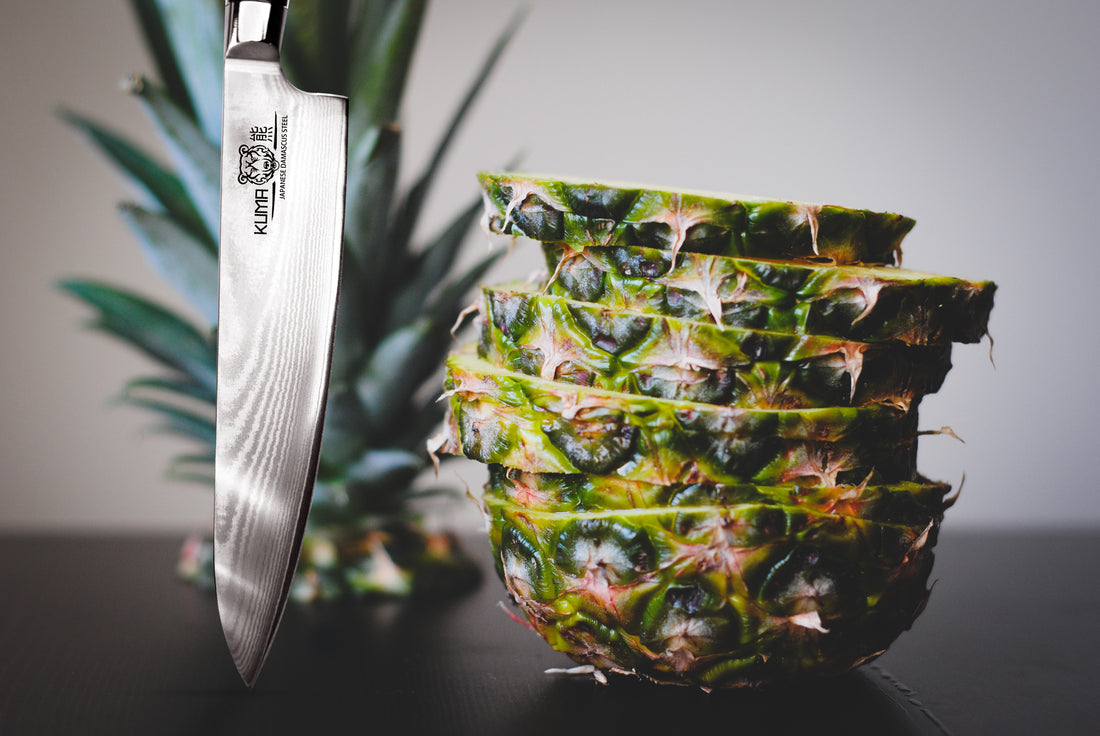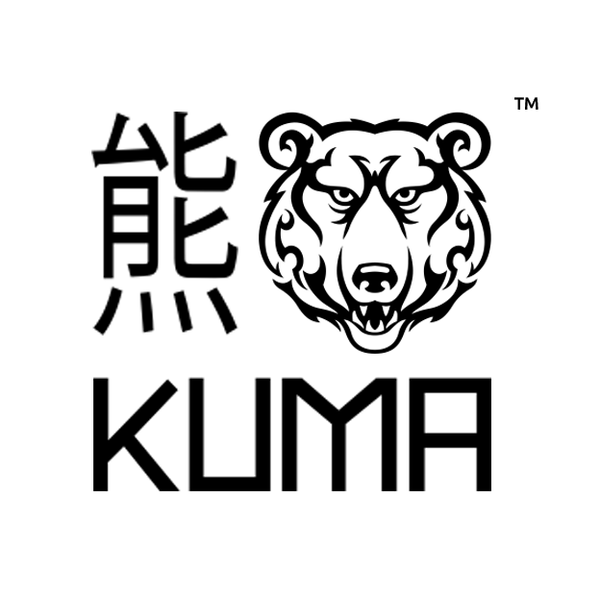
KUMA Damascus Steel Knife: Professional Quality Right at Home
Share
Whether you are a professional chef or an avid home cook, the dividing line between efficient food preparation and lackluster kitchen performance often boils down to chef knife quality. Taking the time to research and purchase a quality chef knife is worth your while. Once you’ve made that decision, you’ll be one step closer to mastering those succulent meals and limiting hardware replacement costs at home.
The Chef Knife: Professional Quality Right at Home
One quality chef knife is enough to tackle those restaurant-quality meals right at home. Some people like the variety of 4 or 5 different knives that perform especially well in their engineered niche. With just one KUMA Professional Japanese Damascus Steel Knife, you’re set up for success. Not only does it make easy work of deboning a roast or julienning potatoes, but it’s best selling point is its quality. Professional chefs do their job right the first time around because their tools are the highest tier available. Why not treat yourself to the same advantage in your own home kitchen?
Our favourite kitchen companion from KUMA is available at reasonable prices, so there’s no need to spend a fortune to see your culinary dreams come true.
Visit https://www.amazon.com/dp/B074RMQR9Q for details about the KUMA Professional Japanese Damascus Steel Knife.
Making the Most Out of Your Blade
When you use a chef knife at home, there are two important things to consider. The first is quality and durability, which will be visited in more detail later on. For now, the second is proper handling. A chef knife is a purpose-built tool that can make short work of difficult recipes if in the right hands. And those hands can be yours by following just a few simple handling tips. Improper use can lead to wrist strain or injury and an overall unpleasant preparation experience, so pay attention!
Let’s have a look at the versatility of KUMA’s chef knife and how you can master the art of correctly handling the blade.
- It is easy to use the main part of the blade. But chefs make the most out of their knives because they have learned to use every facet of the tool at their disposal. Take the pointed tip, for example. Use it to cut through thick-skinned foods such as pumpkins, squash, melon and butternuts. You can use the tip to make pre-cuts in these ingredients so that you have more control when cutting with the body of the knife. The tip is also useful in separating the meat from its sinews. As a baker’s tool, the tip of a chef knife can cut and create shapes if you don’t have cookie cutters on hand. As with all knives, don’t use the tip to open cans and bottles. There are other kitchen tools better suited for this purpose.
- The flat side of the blade is great for gently crushing vegetables, garlic cloves, and nuts. You can use it to juice fruits as well. To do this, hold the knife on a flat surface and slowly apply pressure to the wide part of the blade with your hand.
- The chef knife excels when cutting and chopping denser food items too. Thin bones, celery, carrots, nuts and meat (with or without the bones) are best cut by the heel of the blade, which is near the handle. The heel is the heaviest and thickest part of the knife, so it is best suited for these tougher ingredients.
- Finally, the cutting edge of the knife is perfect for general-purpose food preparation. It’s solid and is easy to use. Softer meats, vegetables, fruits, and herbs are no match for the KUMA Professional Japanese Damascus Steel Knife.
Taking Care of a Japanese Damascus Steel Knife
If you want your chef knife to last for years to come, it’s important to know how to best clean and maintain it. The chef knife is a central player in the kitchen. When it is properly cared for it will out-perform lesser knives again and again. To clean your kitchen knives, stick with simple warm, soapy water and a soft washcloth. Be sure to dry your blades with a towel right away. Here are a few other pointers to consider:
- Dishwashers can harm steel utensils over time. Keep kitchen knives far from them.
- For your own safety, do not leave sharp knives in the kitchen sink submerged with other utensils. Wash them separately.
- Always prepare ingredients on a quality cutting surfaces that will not slide around during use.
- Keep your knives stored in a separate area from your other dishes and utensils. If they have individual storage pods, even better. Dust and moisture can shorten the lifespan of steel knives.
- As always, keep out of reach of children.
Professional or Amateur, the KUMA Chef Knife is for You
Even though the word “chef” is in its name, don’t get scared away and decide it has no place in your home kitchen. While chef knives are always found in the hands of chefs in top-rated restaurants, there’s no reason why the general public can’t use a chef knife. KUMA blades are designed for use in any kitchen and you will enjoy its versatility and durability.
Regardless of the task being performed, the KUMA Professional Japanese Damascus Steel Knife is on the cutting edge of technology. The blade measures 8 inches in length from the base of the blade to the tip. Most chef knives are anywhere from 8 to 12 inches. Chef knives are great because their length makes them an ideal cutter, as you can take advantage of the full length of the blade. Another notable feature of the KUMA chef knife is its curved edge. This isn’t just for looks. It is functional in its design because it allows you to slice and dice food ingredients with ease. No matter its application, this knife can conquer any other kitchen tasks such as chopping, mincing, slicing, and disjointing meat from bones.
The best part is that the knife is easy to use right out of the box. The more you use it, the faster you will master it. No matter your skill level, the KUMA chef knife is there to give you an inspiring food preparation experience!
If aesthetic presentation and viewing quality is a priority in your cooking world, the 67 layers of premium Japanese Damascus steel not only looks good, but it makes your food look good too. Damascus steel is known for its rigidity, its resistance to pressure and its extraordinary strength. This unique construction sets it a league above inferior blades which are prone to bend and break under strenuous use.
Spend the money to invest in one quality blade and you’ll save yourself the trouble of having to replace it in a few months. A lot of knives with “chef’s knife” in their name look the part of strong and durable to encourage a purchase but underperform in the kitchen compared to KUMA’s chef knife.
The Construction of a Damascus Steel Knife
As you know, every part of a chef knife has a specific purpose and utilises a special function in the kitchen. The more you know about your knife, the more likely it can perform optimally in your hand. By taking the time to study each part of the knife, you can more easily distinguish a genuine knife from an imitation brand.
Handle, Bolsters and Rivets
The handle of a KUMA chef knife is ergonomically designed (purpose-built to be comfortable) to allow both left- and right-handed users to enjoy its delightful qualities without strain. High-quality steel that can withstand pressure is a must. Opting for a lighter weight knife over a hefty monster will also reduce your chances of strain and soreness from extended use.
Rivets hold the knife handle and blade firmly in place. Bolsters are thick and smooth and are located on the top of the handle for a sure grip when working with it. Japanese Damascus chef knives are known for their comfort in the hand due to their hand-polished soft spines. This attention to detail lends you an excellent grip when applying the pressure you need.
Blade
A strong blade means a safe blade when coupled with a sharp edge. There are many chef knives on the market available to you and have all sorts of applications and specialisations. So investing in a quality chef knife assures you of all of the above. Take care to select a knife that is constructed from steel that does not wear out or dull quickly. The material used for the cutting edge needs to be chip-resistant and solidly built. Keep an eye open for high-quality steel blades such as the KUMA Professional Japanese Damascus Steel Knife that give you value for your money.
Spine and Edge
The part of the knife that extends from the handle to the knife’s tip is its spine and is directly opposite the cutting edge. The spine is made from the same material as the blade and is where the strength of a knife is centred. If you see a knife with a bent or otherwise compromised spine, throw it out. It is no longer safe to use.
The edge, naturally, gets the most attention. Its resilience comes from its chosen material. A quality chef knife should be rust-resistant for safety when coming into contact with food. KUMA’s Japanese Damascus steel chef knives have patented V-shape sharpening technology. This means their edges will last long after you open the box for the first time.
Tang
The tang is usually enclosed inside the knife’s handle. The best chef knives have rivets inserted through the tang to the other side of the handle to prevent sliding. Avoid chef knives with a “hidden tang”, which have no rivets whatsoever and are simply a thin slice of steel with a handle glued on. The KUMA Professional Japanese Damascus Steel Knife has a welded tang, which means the blade and the tang are separate pieces of steel. Fear not, the tang and blade are fused together with a high-quality weld so they will not break under pressure. Inferior blades that have welded tangs will break because they have poor welds. If you see that the tang starts to detach from a blade, throw it out.
The Chef Knife: Your Choice Cooking Companion
The chef knife is a versatile and efficient tool from its point of purchase. Its continued quality rests in your ability to care for it and to maintain the blade at home. When you choose the right tool for your kitchen your next meal is only a few cuts away.
If you are on the lookout for high-quality chef knives that are a cut above the mundane, KUMA’s Japanese Damascus Steel Knife is a premium blade that is proving itself in this competitive industry. Its 67 layers of Damascus Steel is not only pleasing on the eyes but a joy to use and a must-have for any kitchen.
Visit https://kumaknives.com/ or the KUMA Amazon storefront page to purchase your next chef knife today!
